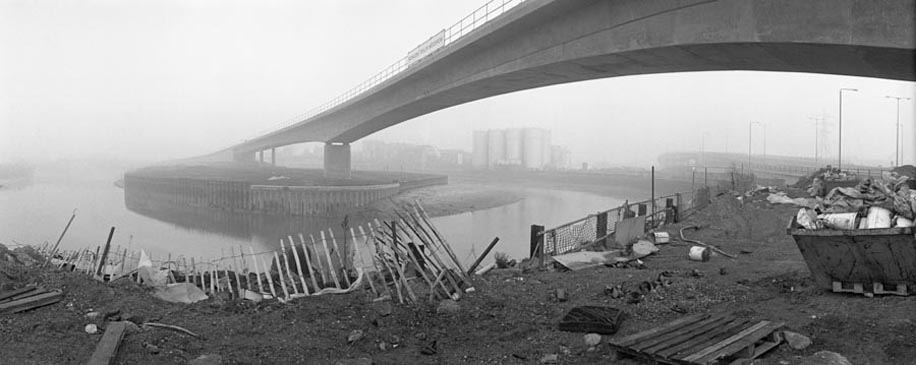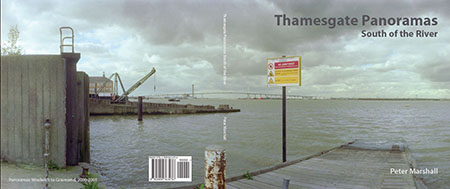For those who missed my speech at the opening of City Streets and River Paths, here is the complete text – less only the few words of introduction and thanks and with a few minor corrections and some stage directions and explanations. None of the illustrations to this post are included in the show, except for the image on the cover of Thamesgate Panoramas.
My Adventures in Panoramic Photography
My adventures in panoramic photography began close to the River Thames, the subject of my pictures in this show. Aged 16 I piled into the back of a battered van with nine other senior sea scouts and we took off for a tour of Scotland. On Skye, four of us were sent to walk across the Cuillins; in exact opposition to Baden Powell’s motto ‘Be Prepared’ we had little suitable equipment and only the sketchiest of maps.
We waded through bogs and streams, up hills and valleys, got soaked by torrential rain and exhausted. We had a long detour as our expected crossing point of a major river was under feet of flood water, but finally on the second day when the sun had come out I climbed a ridge and saw in front of me a magnificent wide vista, across some lower peaks and down into a hidden valley were the sun was glinting on a lake.
I reached for my camera – there were still a few pictures remaining on the roll of 20 I’d bought for the fortnight holiday – raised it to my eye and immediately was hit by a deep frustration. The scene was this wide but the picture could only show this. (You will have to imagine my wide flung arms narrowing to a ‘standard’ lens view.)
The next day, coming down what are perhaps Britain’s most impressive mountains to our rendezvous I had another unforgettable panoramic experience. Losing my footing I found myself taking a vertical route through the air, the splendid view whirling upside-down for a second or two – and then – oblivion! (My right fist slammed into my left palm. In the event I came round to the anxious face of one of my companions who had climbed down more slowly to the small patch of grass on which I had landed, the large rucksack on my back cushioning the fall – but on the opening night I left my cliff hanging.)
The history of panoramic photography is virtually as old as photography itself; in the Daguerreotype era two approaches emerged that are still with us. The first was simply to take several pictures and display them side by side, and the second – patented in Austria in 1843 – involved some ingenious clockwork rotating a lens to scan the image onto a curved plate behind.

Around 20 years later I made my first successful panorama by the first method, once again close to the Thames, on Bow Creek – the final few tidal miles of the River Lea, where the river turns through around 360 degrees in the first of two great bends – squeezing through a gap in fencing on Orchard Place and taking a careful series of five overlapping images as I rotated the camera on the tripod. Back home I printed these, trimmed them carefully and mounted them in a line. They almost fitted together (and the sixth on the right or the set I had to discard.)

Years later I combined them digitally with this result for an article on making panoramas
Ten years later still I read the book on Panoramic Photography, with its rules on making panoramas most of which I still regularly break today, but it did inspire me to save for a Japanese clockwork swing lens camera. Soon after I bought it I went back to Bow Creek, now a building site, and left sunny central London to find the area covered in dense fog. I could hardly see the viaduct of the Dockland Light Railway being constructed that I’d come to photograph.
Shivering with cold I almost went home without taking a picture, but I’d made a long journey so thought I’d take one or two. You can see a little more in the pictures than I remember and one of them became one of my best-known pictures – and the first of mine to somehow mysteriously enter the Museum of London collection.

Docklands Light Railway crosses the River Lea, 1992
My earlier pictures on the wall from around 2000 came partly as a result of the breakup of the Russian Empire. This and the digital revolution that created the World Wide Web enabled me to order a Russian-made miniature swing-lens camera through the Ukrainian black market. It arrived as a ‘gift’ in plain brown-paper wrapping for £170 – probably the only camera I’ve ever bought that I’ve dared to tell my wife how much it cost.
Its big advantage was that – unlike the expensive Japanese model which made do with two arrows marked on its top to define its view – it had a viewfinder. During exposure the lens swings round through around a third of a circle, recording a roughly 120 degree view onto normal 35mm film, though the frames are the same width as a medium format camera. Some of the pictures from the show are in this book

(At this point in my speech I should have held up Thamesgate Panoramas, but realised I’d left it in my bag on the other side of the room. But I did go and get the next exhibit below.)

Digital photography now means everyone has a camera or phone that can take panoramas, though for seamless high quality results you still need to take a series of images and stitch them together with specialised software. With Mireille Galinou’s help I was able to gain entry to a number of gardens behind those high private walls of St John’s Wood and make a series of images for this book and a show at the arts café she then ran. The image on the back of the book (and now 36 inches wide on my stairs) was produced from around a dozen separate exposures, which between them contained one full dog and around half a dozen dog parts as the animal rushed around the garden.
Since then I’ve been working on a method of making high quality digital panoramas with a single digital exposure, and the second half dozen of my images, from the Thames path in Battersea and Wandsworth were produced in this way.
Of course, in the end the techniques are just a means to an end, and it is the pictures that matter. I hope you enjoy them – and thanks for coming.
____________________________________________________________

I wrote a little about the methods I was trying to make digital panoramas in January’s post New Panoramas, which included the above image. Unfortunately I got the maths slightly wrong and failed to display it correctly in the post. Here is how it should have looked (and it now does, as I’ve just corrected the original.)
The recent images in the current show are all roughly 42 x 22 cm, giving them an aspect ratio of 1.9 which I’m now using as a standard. It would have been good to print them larger – and at 300 dpi they would print around 75cm wide and would still look good larger still. But the costs of printing and framing dictated a smaller size for this show. Perhaps in the future I’ll be able to show more images and larger images, but for the moment you can see more more or less as I make them in various posts on My London Diary.
______________________________________________________
My London Diary : Buildings of London : River Lea/Lee Valley : London’s Industrial Heritage
All photographs on this and my other sites, unless otherwise stated, are taken by and copyright of Peter Marshall, and are available for reproduction or can be bought as prints.
To order prints or reproduce images
________________________________________________________